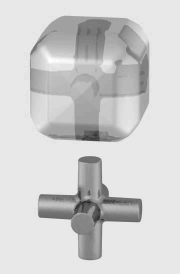With our interest in 3D photography and video, we can get stuck on thinking 3D is just

about photography or movies.
But the future of 3D is vastly larger. As 3D monitors and 3D TVs become wide spread – which is likely a few years out yet – consider the impact this could have on line shopping. And especially when glasses-free displays are common on computers, tablets, phones and HDTVs and the use of 3D is no longer a gimmick but the ordinary.
No longer would we expect to look at a little photo on the web site when choosing a product. Instead, we will likely look at a large 3D view or 3D model that we can rotate and examine, almost as if it were in our hands.
True 3D is also coming. Think “Holodeck” at a small scale. I know people working on this type of technology and for now, the goal is desktop sized “Holodeck” perspectives that enable engineers to design parts in their CAD system and then create a view – not just a mapping of 3D to a 2D display (like the image that accompanies this article) – but a volumetric display which you can walk around and see from all sides.
Add in 3D scanning technology – its available off the shelf today from Microsoft and its called Kinect. Use future 3D scanners to capture information about parts and components or the layout of a kitchen that is to be re-modeled. Or to capture a 3D model of yourself to then use in a virtual clothes fitting exercise where 3D modeled clothes are mapped to your body and checked for size, before you purchase online. So much for retail show rooms? And of course, this can all tie in to 3D printing. Or deliver a 3D virtual world to use from our remotely controlled 3D-seeing robot.
Even traditional 3D imaging can provide us with new perspectives. I enjoy shooting macro 3D – which is close ups of small objects in 3D. Because they are so small we have to get our face so close to the subject that we lose 3D depth perspective. But our camera can capture 3D depth at close range and enlarge it for our viewing.
Similarly, what about slow motion 3D? While we are used to seeing 2D slow motion in sports, 3D slow motion may reveal new insights. And then, what about slow motion macro 3D? Now we may be able to see things that we miss entirely today because we cannot see depth at close range, and definitely not in slow motion.









